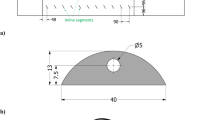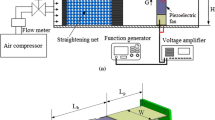Abstract
Most of the vortex generators are static and used in fin-and-tube heat exchangers, whereas this paper presents experimental and numerical research on the effects of piezoelectric fan array in single pass solar air heater having one side heated and the other three sides insulated. The average Nusselt number of the rectangular channel is compared in detail with different Reynolds number of the air. Two different flow direction configurations including counter flow and downstream flow has been tested. The results show that the piezoelectric fan as a vortex generator can increase the local and average Nusselt number effectively. The average Nusselt number is increased by 40~100%, whereas the pressure drop is increased by no more than 30%. The counter flow has higher local and average Nusselt number compared to the downstream flow, while higher pressure drop in the counter flow setup can be found compared to the downstream flow setup. According to the numerical simulation results, this is because the most longitude vortices are concentrated in the middle of the absorber plate and attached or reflowed to the plate in the counter flow setup. However, most of the vortices are concentrated in the back end of the plate or out of the plate in downstream flow. All of these, result from the different velocity gradient distribution at the near-wall of the heated surface. The existences of the PE fan bracket decreases the pressure drop in the downstream flow setup.






































Similar content being viewed by others
References
Pavel Charvat MO, Mauder T, Klimes L (2012) A solar air collector with integrated latent heat thermal storage. Experimental Fluid Mechanics 25. https://doi.org/10.1051/epjconf/20122501028
Patil AK (2015) Heat transfer mechanism and energy efficiency of artificially roughened solar air heaters—A review. Renew Sust Energ Rev 42:681–689. https://doi.org/10.1016/j.rser.2014.10.063
Alam T, Saini RP, Saini JS (2014) Effect of circularity of perforation holes in V-shaped blockages on heat transfer and friction characteristics of rectangular solar air heater duct. Energy Convers Manag 86:952–963. https://doi.org/10.1016/j.enconman.2014.06.050
Bekele A, Mishra M, Dutta S (2014) Performance characteristics of solar air heater with surface mounted obstacles. Energy Convers Manag 85:603–611. https://doi.org/10.1016/j.enconman.2014.04.079
Cadafalch J, Cònsul R (2014) Detailed modelling of flat plate solar thermal collectors with honeycomb-like transparent insulation. Sol Energy 107:202–209. https://doi.org/10.1016/j.solener.2014.06.003
Youcef-Ali S (2005) Study and optimization of the thermal performances of the offset rectangular plate fin absorber plates, with various glazing. Renew Energy 30(2):271–280. https://doi.org/10.1016/j.renene.2004.04.009
Kumar R, Chand P (2017) Performance enhancement of solar air heater using herringbone corrugated fins. Energy 127:271–279. https://doi.org/10.1016/j.energy.2017.03.128
Naphon P (2005) Effect of porous media on the performance of the double-pass flat plate solar air heater. International Communications in Heat and Mass Transfer 32(1):140–150. https://doi.org/10.1016/j.icheatmasstransfer.2004.11.001
Bergles AE (2002) ExHFT for fourth generation heat transfer technology. Exp Thermal Fluid Sci 26(2–4). https://doi.org/10.1016/S0894-1777(02)00145-0
Jacobi AM, Shah RK (1995) Heat Transfer Surface Enhancement through the Use of Longitudinal Vortices:A Review of Recent Progress. Exp Thermal Fluid Sci 11(3). https://doi.org/10.1016/0894-1777(95)00066-U
Skullong S (2014) Experimental Investigation on Turbulent Convection in Solar Air Heater Channel Fitted with Delta Winglet Vortex Generator. Fluid Dynamics and Transport Phenomena 22. https://doi.org/10.1016/S1004-9541(14)60030-6
Tang L-H, Min Z, Xie G-N, Wang Q-W (2009) Fin Pattern Effects on Air-Side Heat Transfer and Friction Characteristics of Fin-and-Tube Heat Exchangers with Large Number of Large-Diameter Tube Rows. Heat Transfer Engineering 30(3):171–180. https://doi.org/10.1080/01457630802304253
Kimber M, Suzuki K, Kitsunai N, Seki K, Garimella SV (2009) Pressure and Flow Rate Performance of Piezoelectric Fans. IEEE Transactions on Components and Packaging Technologies 32(4):766–775. https://doi.org/10.1109/tcapt.2008.2012169
Abdullah MK, Ismail NC, Abdullah MZ, Mujeebu MA, Ahmad KA, Ripin ZM (2012) Effects of tip gap and amplitude of piezoelectric fans on the performance of heat sinks in microelectronic cooling. Heat Mass Transf 48(6):893–901. https://doi.org/10.1007/s00231-011-0944-z
Li X-J, J-z Z, Tan X-m (2017) Convective heat transfer on a flat surface induced by a vertically-oriented piezoelectric fan in the presence of cross flow. Heat Mass Transf 53(9):2745–2768. https://doi.org/10.1007/s00231-017-2019-2
Bailey PH, Williamson WF (1965) Some experiments on drying grain by solar radiation. J Agric Eng Res 10(3):191–196. https://doi.org/10.1016/0021-8634(65)90115-0
Tong B (2009) Theory of vortex dynamics. Press of USCT, HeiFei
Lin C-N (2013) Heat transfer enhancement analysis of a cylindrical surface by a piezoelectric fan. Appl Therm Eng 50(1):693–703. https://doi.org/10.1016/j.applthermaleng.2012.07.023
Alastair Hales XJ (2018) A Review of Piezoelectric Fans for Low Energy Cooling of Power Electronics. Appl Energy 215(C):321–337. https://doi.org/10.1016/j.apenergy.2018.02.014
Lin CN, Jang JY, Leu JS (2016) A Study of an Effective Heat-Dissipating Piezoelectric Fan for High Heat Density Devices. Energies 9(8):610
Maaspuro M (2016) Piezoelectric oscillating cantilever fan for thermal management of electronics and LEDs — A review. Microelectron Reliab 63:342–353
Shyu J-C, Syu J-Z (2014) Plate-fin array cooling using a finger-like piezoelectric fan. Appl Therm Eng 62(2):573–580. https://doi.org/10.1016/j.applthermaleng.2013.10.021
ASHRAE (1997) ANSI_ASHRAE 51–07 (ANSIAMCA 210–07) Laboratory Methods of Testing Fans for Certified Aerodynamic Performance Rating
Burmeister L (1976) Convective heat transfer. John Wiley & Sons, New York
Shah RK, London AL (1978) Laminer flow forced convection in ducts. Academic Press, London
Richman JWA (1972) Developing turbulent flow in smooth pipes. Flow, Turbulence and Combustion 28:419. https://doi.org/10.1007/BF00413081
Rao S (2004) Mechanical Vibrations, Fourth Edition edn. Pearson Education Asia Limited and Tsinghua University Press, Beijing
Rahmati Aidinlou AMNH (2017) Heat flux: thermohydraulic investigation of solar air heaters used in agroindustrial applications. Heat Mass Transf 53:12. https://doi.org/10.1007/s00231-016-1864-8
Jie-Zhi Wu H-YM, Zhou M-D (2006) Vorticity and Vortex Dynamics. Springer-Verlag, Berlin Heidelberg
You D, Wang M, Mittal R, Moin P (2006) Large-Eddy Simulations of Longitudinal Vortices Embedded in a Turbulent Boundary Layer. AIAA J 44(12):3032–3039. https://doi.org/10.2514/1.22043
Tang LH, Chu WX, Ahmed N, Zeng M (2016) A new configuration of winglet longitudinal vortex generator to enhance heat transfer in a rectangular channel. Appl Therm Eng 104:74–84. https://doi.org/10.1016/j.applthermaleng.2016.05.056
Ke Z, Chen CL, Li K, Wang S, Chen CH (2018) Vortex dynamics and heat transfer of longitudinal vortex generators in a rectangular channel. Int J Heat Mass Transf 132:871–885. https://doi.org/10.1016/j.ijheatmasstransfer.2018.12.064
Acknowledgements
The authors would like to thank Mr. Jian-feng Ren for his useful comments on this work and special work by Mr. Yu-xian Li for the experiment fixture design.
Author information
Authors and Affiliations
Corresponding author
Additional information
Publisher’s note
Springer Nature remains neutral with regard to jurisdictional claims in published maps and institutional affiliations.
Rights and permissions
About this article
Cite this article
Hu, J., Jing, C. & Zhao, Y. Heat transfer enhancement research of dynamical vortex generator in a solar air heater by using the piezoelectric fan array. Heat Mass Transfer 56, 825–847 (2020). https://doi.org/10.1007/s00231-019-02735-6
Received:
Accepted:
Published:
Issue Date:
DOI: https://doi.org/10.1007/s00231-019-02735-6




